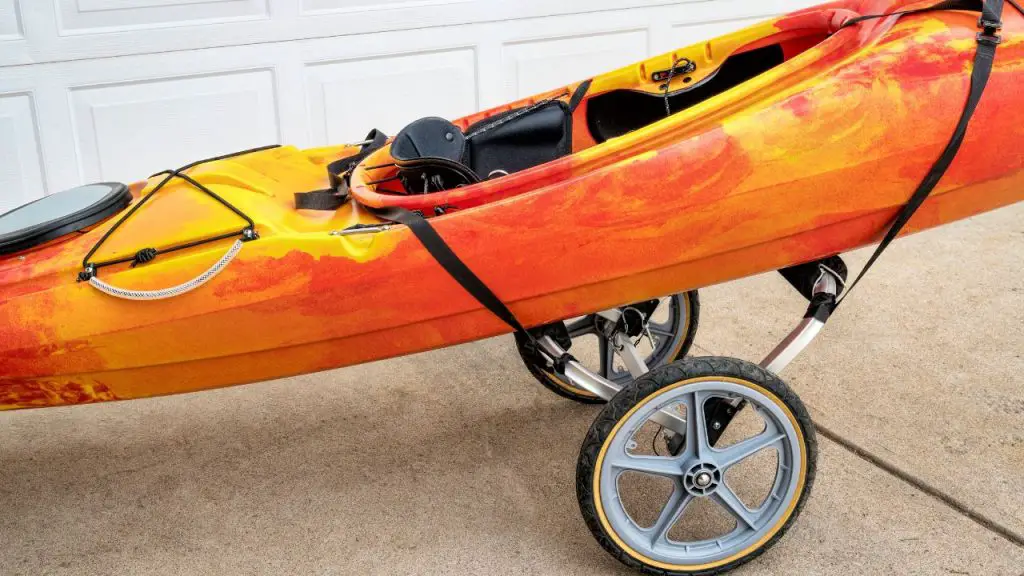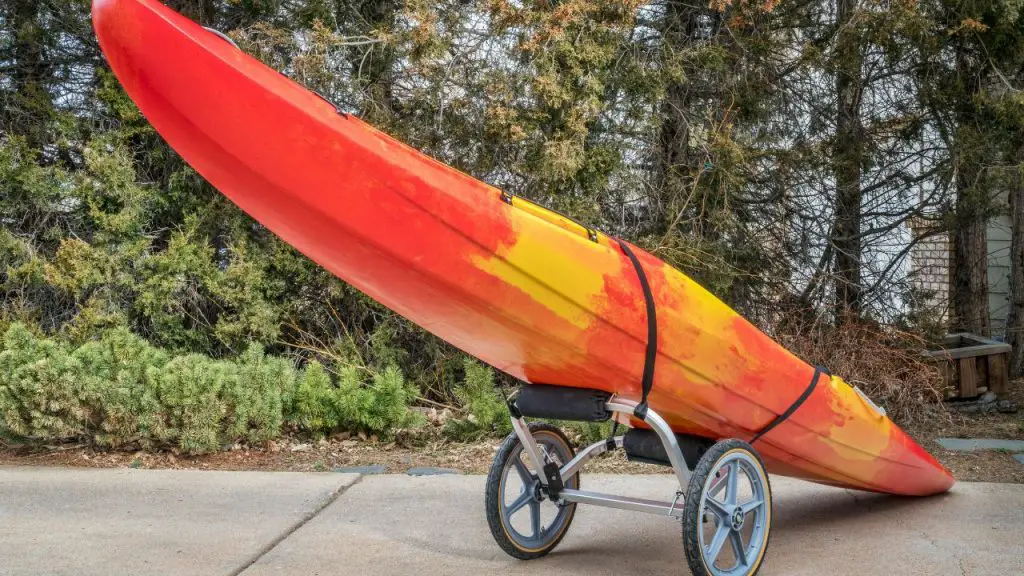Have you considered buying a kayak cart but don’t know how to use them? Using this equipment is straightforward, though it can be challenging for beginners.
How you use a kayak cart depends on the type you buy. If you already have it, just determine what you have, and we will show you how to use it for towing your boat. Most likely, it is a strap style or plug style. These are the main categories of kayak carts.
Read on to find out how to use kayak carts, including the benefits and drawbacks. We will get detailed information about each type.
Table of Contents
How Do Kayak Carts Work?

A kayak cart, like any other machine, helps to make transporting a kayak easier. This hand-pulled equipment has a frame, two wheels, and kayak securing mechanism. The wheels take all the weight of your kayak, making it easy to pull on various terrains.
You can use a kayak cart to transport literally any kayak that fits. There is no standard for this equipment. Provided your kayak fits inside its bed, you can transport it with this cart. Leisure and fishing kayaks can both be transported using this method.
Types of Kayak Carts
Many types of kayaks exit, depending on how you group them. However, the most commonly known are the strap style and plug-style kayak carts. But what are the differences? Let’s explore more!
Strap-Style Kayak carts
The most common type of kayak cart is the wheeled one with a cushioned frame to lay the kayak. This type has straps as the securing mechanism.
The straps wrap around the kayak’s hull and fasten it to the cart. Start-style kayak carts can carry kayaks of different sizes.
Kayak Cart with Airless Tires
Plug-Style Kayak Cart
As the name suggests, plug-style kayak carts use scupper plugs instead of straps to secure kayaks onto the frame. The kayak is held on the cart’s frame by poles extending from it and passes through the scupper holes in the kayak.
Plug-style kayak carts are best suited for carrying only sit-on-top kayaks with scupper holes.
GanFindX Lightweight Design & Quick-Detachable Sit on Top Kayak
How Do You Choose a Kayak Cart?
Buying a kayak cart is not as easy as many people perceive. The choice of what to buy depends on structure, but you should consider other factors. Terrain, kaya’s size, material, and many others influence your buying decision.
Where To Use The Kayak Cart
Look at the various options available and choose the kayak cart most suited for your region. Kayak carts are designed for different terrains.
For instance, those with pneumatic or air-filled wheels are best for sandy beaches. These are the best option if you often use your kayak in the sea and launch from sandy beaches.
Getting the wheel type wrong for the terrain will not make transporting your kayak with a cart easy. Instead, you will have to deal with an added weight of the two.

Wheel Size
Apart from the kayak cart’s wheel type, its size also matters. The larger and wider wheels reduce the pressure the cart and its content exert on the ground. That makes them ideal for sand and soft surfaces. On the other hand, taller wheels make the cart more stable and can be pulled closer to the kayak while still in deeper waters.
Wheel Material
Undoubtedly, the wheels of a kayak cart determine its performance on different terrains. In this case, we will look at the wheel material you are likely to find fitted on the kayak cart you want to buy.
Kayak cartwheels can be pneumatic (air-filled) or solid (rubber or plastic). Which one is the best choice and in which conditions?
Pneumatic rubber tires get better traction and are the best choice for transporting kayaks on sandy, rough, or rugged terrain. You also get nearly a smooth ride. However, they are more expensive and prone to puncture or deflating. They also require high maintenance.
The other option is a kayak cart with solid rubber or solid wheels. These are great because of being puncture-proof, maintenance-free, and great on hard surfaces. However, they don’t have an impact-absorption property like air-filled wheels.
How to Use Kayak Carts
Using your kayak cart to transport a kayak depends on whether you have a strap-style or plug-style cart. The procedure of loading and securing a kayak on it slightly varies.
The most straightforward kayak cart is the plug-style, but even the other is not complicated. Let’s walk you through the two cases.
For Strap Style Cart
The following is the step-by-step guide on how to use a strap-style cart:
- Place the kayak cart close to your boat
- Load the kayak into the cart by lifting the stern from the rear and placing it on the cart. Align it by adjusting the bow position.
- Ensure an even weight distribution when making the positional changes, and no side of the kayak is closer to the edge than the other. Achieving balance is the ultimate goal.
- Secure the kayak onto the frame using straps. Don’t make it too tight or loose but just an appropriate tension.
For Plug Style Cart
Use the following steps if you have a plug-style kayak cart:
- Tip your kayak
- Lift your cart and tighten the plug poles into the most appropriate scupper holes on the hull bottom.
- Recheck the balance and ensure you can safely raise the bow and pull it onto the kayak cart.
- Apply power to the cord and fasten them to secure the kayak.
- Push down on the lift handles, and you are all set!
Pros and Cons of Kayak Carts
Kayak carts are essential equipment for transporting kayaks on different terrain. They come with many benefits and advantages, but not without some drawbacks.
Let’s quickly highlight some pros and cons of a kayak cart to help you decide on whether or not to buy one.
Pros:
- Reducing the effort required to haul your kayak from place to place.
- Decreasing trip frequency – you can carry your kayak and all safety or fishing gear in the cart at once.
- Extend a kayak’s life – no dragging your kayak in the mud, dirt, pavement, or rugged terrain that causes expensive damage.
- Some kayak carts are easy to fold or quickly disassemble to store in your hatch or strap to your deck.
- Adaptive programming – transport paddlers already seated in the kayak into the water.
Cons:
- Wider kayaks do not easily fit in a kayak cart
- Kayaks can slip off during transportation
- Pulling a loaded kayak over large rocks, logs, and branches, steep and immediate, and thick mud (or large puddles) require physical strength.

FAQs
What do you do with a kayak cart while kayaking?
Leaving your kayak cart onshore can be risky. So, you need a way to secure it and deter thieves from running away with your equipment.
You can strap it to the kayak if you are just fishing. Alternatively, you can pop off the wheels and tie the cart to a tree.
How do you use a sit-on-top kayak cart?
Using a sit-on-top kayak cart is straightforward, but it is only for kayaks with scupper holes. The tapered cones on this cart fit into the holes to secure it in place.
They prevent side-to-side movement when towing your boat. So, just ensure the cons are correctly inserted into the scupper holes on the kayak when loading.
Where do you store your kayak cart?
You can store your kayak cart on the boat when paddling. Just turn it upside down into the scupper holes and use a traditional strap to secure it.
Do you need scupper plugs on a kayak?
No. You don’t need scupper plugs on your kayak because they are already present on your kayak cart. Your boat should only have scupper holes where scupper plugs fit in to hold it in place when towing.
How do you put a kayak on a kayak cart?
Putting a kayak on a kayak cart depends on the cart type or structural design. Your kayak cart can be strap-style or plug-style. Consider this video tutorial for detailed steps.
Conclusion
Using a kayak cart to transport your kayak comes with many benefits. The most apparent one is reduced effort, but makes your kayak last longer.
With this equipment, you will no longer drag your boat on hard surfaces, which leads to costly damages due to abrasion.
However, you should be keen if you want to buy the best kayak cart. Consider all the factors mentioned here and go for the design of your choice.
Thank you for reading this article at WindPaddle. We appreciate your time and will be grateful if you can share this post with fellow paddlers to inform them about the need to use kayak carts. Also, you can explore the site for related content.


